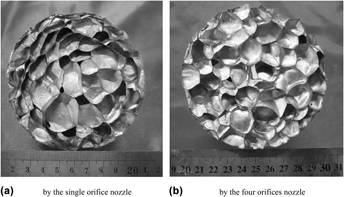Published online by Cambridge University Press: 08 April 2015

The influences of parameters on the bubble size in aluminum alloy melt during the gas injection foaming process were studied. The four parameters were the orifice diameter (0.4–3.0 mm), the orifice numbers (1 and 4), the gas chamber volume (11–800 cm3), and the gas flux (10–282 L/h). It was found that the bubble size decreased with the decrease of the orifice diameter and the gas chamber volume, and with the increase of the orifice number. The effect of gas flux showed a dual-stage at different gas fluxes: the “metastable large bubble stage” and the “stable bubbling stage”. A modified semiempirical formula and a concept of “effective gas chamber volume,” which is the nominal chamber volume divided by the effective orifice number, were proposed. The bubble size calculated by the modified formula with the effective gas chamber volume agreed well with the experimental data.